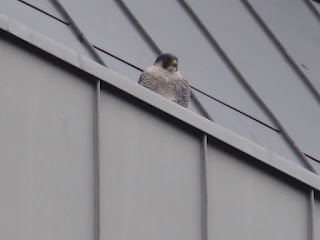A Wren climbed the trunk of an oak tree.
A Pied Wagtail looked for insects in the joins of the slate roof of one of the boathouses.
The flat area in Hyde Park where the Crystal Palace was erected for the Great Exhibition of 1851 is now football fields. But the clay soil is completely impervious, so that heavy rain turns it into a marsh. A Pied Wagtail found it a good hunting ground for insects and worms.
A Carrion Crow had pulled some rubbish out of a bin. It attacked an empty packet of French chicken flavoured crisps, found there wasn't much left in it, and moved on to something from Harrods.
The female Peregrine was on the barracks tower.
There was a very dishevelled Black-Headed Gull on the edge of the Serpentine.
A Cormorant caught a perch under one of the Italian Garden fountains.
A young Cormorant, still with a pale front, perched in the dead willow below the parapet.
A Great Crested Grebe was preening at the island. One of its feathers came loose and the grebe prudently ate it. They eat feathers, their own and others that they find floating, to wrap up fishbones and protect their insides from being scratched.
A pair of Mute Swans ate reeds in the bed below the Diana fountain.
Three female Tufted Ducks did a bit of synchronised preening.
The nymphaeum next to the Italian Garden is being repaired. The wood panelling had decayed on the side exposed to the sun, though it remains sound on the shaded side. Replacing it is quite a job. The foreman said that he was using a Victorian moulding plane to cut the mouldings.
He also told me that the nymphaeum is not, as I had supposed, contemporary with the loggia and stonework in the Italian Garden, though both are made of similar Portland stone. It dates from the time of Queen Anne -- I ought to have noticed the AR monogram at the top of the pediment. Originally it stood on the edge of Kensington Gardens south of, and facing, Kensington Palace. But when houses were built along Kensington Road in the 1870s, it was decided that the back of the structure, which is just of brick, was an obstacle to the view of the park, so it was moved to the Italian Garden, which had been completed a decade earlier.
The brickwork behind the panelling is not of the standard we expect from Victorian bricklayers. It wasn't meant to be seen since it was hidden by the panelling, but it still looks a sloppy job.
Two good pictures by Mark Williams from a brighter day: a Lesser Black-Backed Gull with a crayfish ...
... and a Robin singing in St James's Park.














That looks like a pretty difficult piece of restoration. I'm sure you've told the story before and I'm also sure I should know the answwer, but why is that building called the nymphaeum?
ReplyDeleteAlways a cheering notion that birds should put to their own uses whatever we humans throw their way, be it a football field or a packet of crispy chips.
If that building has a proper name I don't know it, so I call it the nymphaeum because that is a building dedicated to nymphs, usually water nymphs of which there are two stone ones nearby, and nymphaea tend to have concave or apsidal fronts.
DeleteHere is some more on the alcove, which is "Queen Anne's Alcove" - by Christopher Wren it seems https://www.royalparks.org.uk/parks/kensington-gardens/things-to-see-and-do/memorials-fountains-and-statues/queen-annes-alcove
ReplyDeleteThanks, very interesting. The quality of Mr Cowley's brickwork has now been exposed to public gaze, but only for a day as the craftsmen have nearly finished fitting the new panels.
Delete